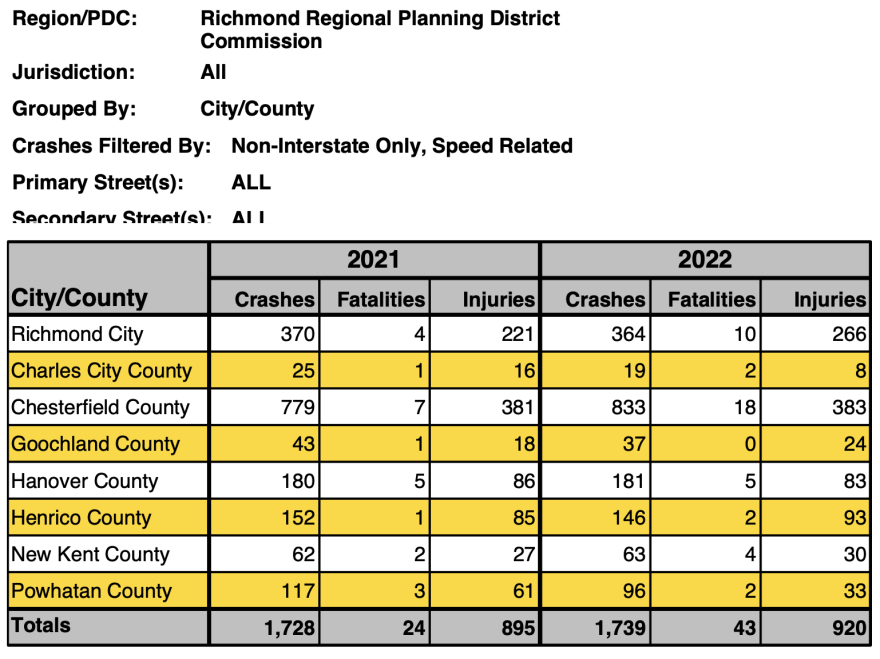About 100 people gathered at Richmond’s Main Street Station on Wednesday to hear how city officials are addressing the alarming increase in local traffic injuries and fatalities.
According to the Virginia Department of Motor Vehicles, in 2022 there were 10 fatalities in the city — six more than 2021; and 266 injuries in 2022 compared to 221 in 2021.

Resident Jenny Cox says she was recently hit by a car while trying to cross East Grace and North Second streets. Several popular restaurants are located near this intersection, including Perly's, Stella's, and Ay Caramba. She came to the symposium to get a better understanding of how officials will make streets safer for her.
“I'm just interested in learning more about how the city plans to make the 500 intersections they mentioned safer and also like what those intersections are,” she said. “So far, I haven't been able to find a list or anything of what those intersections are.”
According to the city’s Speed Management Program, more than 150 streets are in line to get either speed tables or raised crosswalks.
Neither East Grace nor North Second Street, where Cox was hit by a car, are listed.
Public Works Director Bobby Vincent said DPW tries its best to take care of all nine council districts equitably. The department maintains over 200 miles of alleys, 800 miles of sidewalks, and over 2,500 lane miles throughout the city.
In addition to those miles, Vincent said the department also has a “serious” network of trees, sewer, gas and water lines and streetlights to maintain.
“Everything within the public right away that we have to contend with in terms of making public infrastructure and our public right away better,” said Vincent.
Funding infrastructure projects has come a long way
Cox said even though the city is heading in the right direction when it comes to improvements, they need to do more.
“The problems are so vast, and so great," said Cox. “The funding is better than it used to be. But it's not where it really needs to be to address all of these pedestrian and cyclist injuries spots in the city.”
Vincent said the city recently received $21 million in federal funding to help with the Complete Streets program. That grant aims for localities to design safer streets for all users. He said much of the money will be used to repave streets, because it’s a good way to fix multiple infrastructure issues at once.
"When you pave a street, you could put down speed tables, you could change our stop signs, you could trim back trees, you could take care of some curb and gutter,” he said. “So, the more money that we can put towards paving, the more complete streets that we can wind up doing.”
Vincent said the amount of funding infrastructure projects has grown in the past 10 years. Back then, Vincent said his department received about $3 million. After Mayor Levar Stoney was elected, he said that number increased to $16 million.
“Our City Council has been listening to you all,” said Vincent. “And now we are up to receiving over $30 million a year to go toward capital improvements. These are capital maintenance–type improvements.”
He said part of trying to make the city safer for pedestrians and cyclists goes together with making it safer for drivers.
“To create a better understanding and awareness for those individuals who are driving vehicles is to put paint down, put signs up, put infrastructure in the way,” said Vincent. “And that’s how we’re currently spending that $30 million toward infrastructure.”

Richmond’s three-pronged approach to transportation
The city’s Speed Management Program is just one of three programs shaped around street safety infrastructure.
Another is Richmond Connects, a “strategic multimodal transportation plan” that seeks to ensure communities of color and low-income communities aren’t left out of future transportation plans.
There are actually two plans. One is an action plan that “will identify and prioritize transportation projects and programs for City implementation in the next five to 10 years;” and a scenario plan that “will identify high-level projects and policies for the 2050 planning horizon.”
Other city officials in attendance included city transportation engineer Mike Sawyer, and Dironna Moore-Clarke, Administrator for the City of Richmond, Office of Equitable Transit and Mobility.
Clarke said, working through Richmond Connects, one of her department’s goals is to make areas like Southside and Jackson Ward more accessible by bike, walking and transit — especially when the latter neighborhood will be reconnected by a capping project over parts of Interstate 95.
“We want to be able to have connectivity for both transit and pedestrian from those areas,” said Clarke, “making sure that there's a number of gateways into the city, safe for walking and biking, along with our automobiles, in our buses. Ensuring that transportation investments will indeed improve access to housing and jobs.”
The other program is the city’s adoption of Vision Zero, is a global strategy started in Sweden in the 1990s that seeks to eliminate all traffic fatalities and severe injuries while at the same time increasing equitable mobility for everyone.
When City Council adopted Vision Zero in 2016, there were nine components outlined to help achieve it. Those included developing an action plan, being data driven in terms of how to use resources to fix areas that will have the greatest impact, having community engagement and making a political commitment to “achieve zero traffic fatalities and severe injuries among all road users.”
Vincent said part of the problem with Vision Zero is trying to get people — especially drivers — to obey it.
“We all know the faster somebody goes, the more likely the situation exists for someone to be injured if they are in fact struck as a pedestrian,” said Vincent. “If you obey the rules of Vision Zero, where you don't drive fast, drunk, while looking at your cellphone, unbuckled, you lower the chance of hitting a pedestrian or bicyclist or another motor vehicle.”
In a email to supporters prior to the event, Brantley Tyndall of Bike Walk RVA, which advocates for safe and equitable streets for bicyclists and pedestrians through Sportbackers,wrote that though the org was thankful that Richmond was holding the event: “It is important to be open-minded while also staying laser-focused on the fact that the most impactful way to slow speeds is through INFRASTRUCTURE and STREET DESIGN. PSAs and asking drivers politely will do little to change driver behavior. Do not lose focus on demanding safer streets that are difficult to speed on.”
While Bike Walk RVA does agree with the city on adding speed tables, its list of recommendations goes further: narrowing streets, adding bike lanes and multi-use paths, adding raised high-visibility crosswalks and having photo speed enforcement.
Things listed that the org doesn’t think would help reduce speeding include using Public Service Announcements to encourage drivers to slow down — and repaving streets.
As Tyndall wrote, “Simple repaving (if anything, this ENCOURAGES speeding).”



